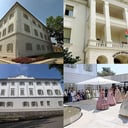
Bethlen-kúria in the little village of Sajóörös sits quietly on the map of northeastern Hungary. People often overlook it in favor of grand castles or the more famous palatial houses dotting the countryside, but spending time under its ancient eaves is like listening to a whispered conversation between past centuries. Wander inside and you’re met with a gentle kind of hospitality—the sense that history still lingers here, not in a stuffy way, but alive, breathing, and eager to share stories if you’ll listen.
Bethlen-kúria isn’t monumental in the gigantic, awe-inspiring sense that you see in the travel brochures for Paris or Vienna, but that’s rather its charm. From the outside, it radiates an old-world elegance, surrounded by a patchwork of trees and with a modest, almost serene demeanor. The building itself dates back to 1796, a year neatly inscribed along local memory, commissioned by the aristocratic Bethlen family—a lineage well woven into the complicated fabric of Hungarian nobility. Unlike many other mansions in the region which have undergone vast renovations, Bethlen-kúria still carries its original architectural character. The neoclassical style is obvious: tall windows, simple columns, and a symmetry pleasing to the eye. If you look closely, you’ll notice small details—a crest here, a cornice there—each whispering of the family’s once-grand social standing.
Inside, history isn’t just in the artifacts; it’s in the very walls. The mansion’s thick stone keeps in the cool in the summer months and preserves a touch of chill when winter visits the Sajó valley. The ceilings are high, impossible to ignore, and they open up the rooms so that you can imagine the delicate echo of long-ago footsteps. The main hall remains almost as it was more than two centuries ago, a testament to what careful guardianship and a bit of luck can achieve. Choose your favorite window, glance outside, and the lawns roll gently into the rural beyond—occasionally you’ll glimpse a deer or the friendly tail of a local dog. The atmosphere is never hurried. Here, you feel encouraged to pause, to wander slowly, and appreciate things unnoticed in everyday life.
The history here isn’t simply a string of dates and nobility lists. The mansion has played various roles over the years: noble residence, agricultural center, even functioning as a makeshift local administrative building after the shifts of the 20th century. Each era layered its own personality over the previous one, so as you move from room to room, you’re not just inhabiting old spaces, but breathing in the big and small chapters of regional history. Those years after World War II particularly transformed the place. There’s a bittersweet tone in some of the stories told by locals—from here, you can almost trace the arc of modern Hungarian history, from feudal lottery winners to the shifting realities of life under different political systems.
It would be a shame to miss the mansion’s park. Large, old-growth trees provide shade and lend a certain dignity to afternoon walks. Sit a while under the branches, and you might catch the scent of lilacs in spring or the subtle autumnal change in the air by October. The grounds themselves feel like a living diary of Sajóörös—a meeting point for villagers, visiting families, and solitary thinkers alike. You can still spot remnants of the old garden layout, and the local birds seem utterly at home. If your timing is right, you might share the lane with a grandmother coming back from the market or a curious child eager for a story from the “castle.”
After a visit, it’s impossible not to feel you’ve brushed up against something quietly significant—a place gently persisting as time whirlwinds around it. Bethlen-kúria rewards those who appreciate subtlety and the depth of well-preserved history. It’s the kind of place where you don’t need to hurry, nor do you need to be an academic to appreciate the arc of history gently curving through its grounds and rooms. Bethlen-kúria may not shout for your attention, but in its quiet way, it’s unforgettable—inviting you to pull up a chair in history’s living room and spend just a little more time watching yesterday fold seamlessly into today.





